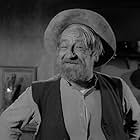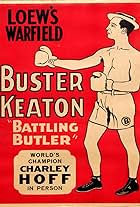After Hollywood, and THE UNKNOWN CHAPLIN, Kevin Brownlow and David Gill did this documentary on Buster Keaton, and how he developed as the leading rival of Charlie Chaplin as number one comic of the Silent Period (Harold Lloyd is number three, and then - supposedly - Harry Langdon, Raymond Griffith, and Laurel and Hardy). Keaton had begun with his parents in a lively, knockabout vaudeville act (literally his father threw him about the stage). When he entered movies it was with Fatty Arbuckle's company, and as Arbuckle's friend and admirer. Unlike most silent performers, Keaton was interested about how movies were made, and actually took apart a camera to study it's workings. He learned to build jokes into his films to develop character. And he never lost his fascination with the power of what films could do. Look at a film like SHERLOCK JR., where he carefully spends time using cutting to make a series of improbable events occur on screen (such as jumping through the chest of a man standing in front of a wall). Chaplin plucks at the heartstrings, Lloyd takes ordinariness and perks it up with dangers, but Keaton is concerned on how man is at the mercy of nature and science. In one long sequence joke in OUR HOSPITALITY, Keaton is being chased to a waterfall set of cliffs. He ties himself to a rope hoping to climb up. An enemy finds the rope and ties it to himself, planning to surprise Keaton when he climbs up. Keaton sees this and yanks on the rope causing his enemy to fall off the top of the cliff into the waterfall, but as the body of the man fall down in the background, Keaton realizes the rope is still tied securely to his own body. Looking stoically into the camera and waiting, a moment later we see Keaton pulled off the screen by the falling body of his enemy. He can fight human enemies, but not the law of gravity.
Keaton did well until 1928, but then family and health problems hit him, especially his growing alcoholism. Stripped of his dignity by a studio boss (Louis B. Mayer) who had no time for has-beens, he became a gag writer. But he still occasionally made films in the sound period. The film shows how Keaton's rise occurred in the 1950s, spurred on by the rediscovery of many of his films. It is a remarkable story of a gifted genius who lived long enough to know he was not a drunken failure but universally admired.





























